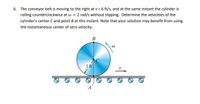Question

Transcribed Image Text:6. The conveyor belt is moving to the right at v = 6 ft/s, and at the same instant the cylinder is
rolling counterclockwise at w = 2 rad/s without slipping. Determine the velocities of the
cylinder's center Cand point B at this instant. Note that your solution may benefit from using
the instantaneous center of zero velocity.
B
1 ft
A
Expert Solution
This question has been solved!
Explore an expertly crafted, step-by-step solution for a thorough understanding of key concepts.
This is a popular solution
Trending nowThis is a popular solution!
Step by stepSolved in 2 steps with 1 images

Knowledge Booster
Similar questions
- A monkey has a 50 cm long tail swinging through circular arcs. a. The moneky prepares to swing through a semicircular arc by grabbing a branch 50 cm in front.What is the angular acceleration as she begin to drop? b. What is the monkeys linear speed at the bottom of this arc, 50 sm below starting point? What is her angular speed? c. The monkey has a mass of 10 kg. What is the tension in her tail at the bottom of the arc?arrow_forwardA flywheel is rotating at an angular velocity of 100 rad/s. A brake is applied to the flywheel and the angular velocity is reduced to 20 rad/s. Find: The produced acceleration by the brake b. The total angle that the flywheel rotates in 15-s period а.arrow_forwardA turntable is off and is not spinning. A 0.9 g ant is on the disc and is 14 cm away from the center. The turntable is turned on and 1.4 s later it has an angular speed of 33 rpm. Assume the angular acceleration is constant and determine the following quantities for the ant 0.7 s after the turntable has been turned on. Express all quantities using appropriate mks units. a => W = V= atan arad a= Fnetarrow_forward
- An ultracentrifuge accelerates from rest to 108600rpm in 2.1min. A. What is its angular acceleration in units of radians per second squared? B. What is the tangential acceleration, in meters per second squared, of a point 9.5cm from the axis of rotation? C. What is the centripetal acceleration, in multiples of g, of this point at full speed?arrow_forward3. A telephone pole has been knocked over by the wind so that it makes an angle of 0 with the vertical. The wind has stopped blowing and the pole is to be cut down as shown. nail L cut Once the cut is across most of the thickness of the pole, the pole begins to tip over. As the pole tips, the bottom of the pole stays attached to the base by the remaining part of the pole that was not cut (but the torque from the base on the tipping pole is negligible). There is a nail (of negligible mass) on the pole located a distance x. The length of the pole from the cut to the top is L. Remember that the moment of inertia of a stick of mass m and length L about its end is mL?.arrow_forwardThe rotating blade of a blender turns with a constant angular acceleration 1.50(rad/s²]. A. How much time does it take to reach an angular velocity of 36. 0 [rad/s] starting from rest? Through how manry revolutions does the blade turn in this time interval? C. What are the tangertial acceleration and tangential speed of an ant sitting on the blade 10.0 [cm) from the axis of rotation during the end of this irterval? D. What is the moment of inertia ofthe ant if its mass is 10.0 (g? E. What is the rotational kinetic energy of the ant? B.arrow_forward
- A. A large rotating cylinder uniformly increases in angular speed from rest to 0.170 rev/s in 28.0 s. What is its angular acceleration in radians per second per second?arrow_forwardPlz use g = 9.8 m/s2 to find if neededarrow_forwardDuring a very quick stop, a car deceleraes at 7.00 m/s^2.a. What is the angular acceleration of its 0.280-m-radius tires, assuming they do not slip on the pavement?b. How many revolutions do the tires make before coming to rest, given their initial angular velocity is 95.0 rad/s?c. How long does the car take to stop completely?d. What distance does the car travel in this time?e. What was the car’s initial velocity?f. Do the values obtained seem reasonable, considering that this stop happens very quickly?arrow_forward
- A bicycle wheel has a radius r = 0.24 m and rotates at a constant frequency of f = 79 rev/min. a. Calculate the period of rotation of the wheel in T seconds b. What is the tangential speed of a point on the wheel's outer edge in m/s?arrow_forwardWhen a fan is turned off, its angular speed decreases from 168 rpm to 64.0 rpm in 6.08 s. A) what is the angukar acceleration of the fan? B) How fast the edges of the blades are moving (in m/s) at time 6.08 s, if they are 86.0 cm long?arrow_forward5. A block m= 5kg sits on a horizontal surface with coefficient of u = 0.2 between the block and the surface. A string runs from this block over a cylinder wheel of radius R = 10 cm and mass m, =2 kg and is attached to a hanging 7 kg friction mass. a. Find the acceleration of the masses, the angular acceleration of the wheel, and the tension in the string on each side. b. Use acceleration to find the velocity after block M moved down by h= 0.5m Marrow_forward
arrow_back_ios
SEE MORE QUESTIONS
arrow_forward_ios